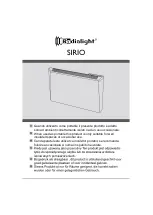
EN
GL
ISH
www.stiebel-eltron.com
SBB 300-600 plus |
19
INSTALLATION
Installation
8.2 Transport
!
Material losses
We recommend removing the cylinder casing for trans-
portation to the installation location to prevent it from
becoming dirty or damaged.
SBB 600 plus
f
f
Both side insulation sections can be removed for transporta-
tion in tight spaces. To do this, remove the cylinder casing.
26
�0
3�
20
�0
00
3
f
f
Use the fixing straps to refit the thermal insulation sections
following transport.
1
1
D
00000
47
88
2
1 Side insulation segment
f
f
Ensure that the closures are positioned in the joint between
a side insulation segment and the thermal insulation of the
cylinder.
9. Installation
9.1 Cylinder casing
Note
Open or remove the cylinder casing before fitting the DHW
circulation and indirect coil lines.
Fit the cylinder casing before installing a threaded im-
mersion heater.
The plinth trim should be fitted after the tightness check.
9.2 Signal anode
!
Material losses
The appliance must not be operated without a consump-
tion indicator or with a damaged one, as water will leak
out once the anode is depleted.
f
f
Affix the label "Signal anode information" in a clearly visible
position on the thermal insulation.
9.3 Solar or heating installation
f
f
Before connection, flush the indirect coil with water.
f
f
Route the connecting lead to the solar or heating circuit con-
trol unit.
9.3.1 Water quality, solar circuit
A glycol/water mixture of up to 60 % is permitted for the indirect
coil in the solar circuit if only dezincification-resistant metals,
glycol-resistant gaskets and diaphragm expansion vessels suitable
for glycol are used throughout the installation.
9.3.2 Oxygen diffusion
!
Material losses
Avoid open vented solar thermal systems and plastic
pipes which are permeable to oxygen.
With plastic pipes that are permeable to oxygen, oxygen diffusion
may lead to corrosion on the steel components of the solar thermal
system (e.g. on the indirect coil of the DHW cylinder).
!
Material losses
Avoid open heating systems and plastic pipes in under-
floor heating systems which are permeable to oxygen.
In underfloor heating systems with plastic pipes that are per-
meable to oxygen and in open vented heating systems, oxygen
diffusion may lead to corrosion on the steel components of the
heating system (e.g. on the indirect coil of the DHW cylinder, on
buffer cylinders, steel heating elements or steel pipes).
!
Material losses
The products of corrosion (e.g. rusty sludge) can settle in
the heating system components and can result in a lower
output or fault shutdowns due to reduced cross-sections.

































